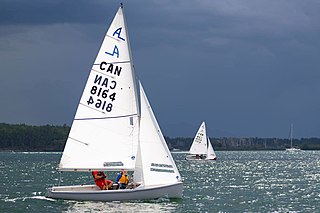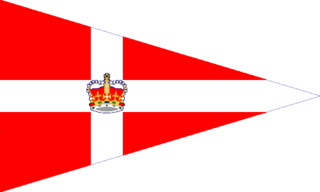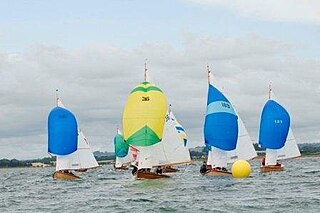Team racing, also known as team sailing, is a popular form of dinghy racing and yacht racing. Two teams compete in a race, each sailing two to four boats of the same class. The winning team is decided by combining the results of each team's boats. This differs from an inter-club fleet race where boats from three or more clubs compete, with the results of each club's boats combined to determine its overall position.

Dinghy sailing is the activity of sailing small boats by using five essential controls:

Dinghy racing is a competitive sport using dinghies, which are small boats which may be rowboats, have an outboard motor, or be sailing dinghies. Dinghy racing has affected aspects of the modern sailing dinghy, including hull design, sail materials and sailplan, and techniques such as planing and trapezing.

The Albacore is a 4.57 m (15 ft) two-person planing dinghy, for competitive racing and lake and near-inshore day sailing. Hulls are made of either wood or fiberglass. The basic shape was developed in 1954 from an Uffa Fox design, the Swordfish. Recent boats retain the same classic dimensions, and use modern materials and modern control systems.
Boat racing is a sport in which boats, or other types of watercraft, race on water. Boat racing powered by oars is recorded as having occurred in ancient Egypt, and it is likely that people have engaged in races involving boats and other water-borne craft for as long as such watercraft have existed.

A yacht club is a sports club specifically related to yachting.

The Moth is a small development class of sailing dinghy. Originally a small, fast home-built sailing boat designed to plane, since 2000 it has become an expensive and largely commercially-produced boat designed to hydroplane on foils though many are still built at home, typically at much lower cost.
The Shannon One Design sailing dinghy is an open centreboard sailing boat raced on the River Shannon, Lough Derg and Lough Ree in Ireland. The boats are 18 feet (5.5 m) long by 4 feet 10.5 inches (1.486 m) beam, drawing 4 feet (1.2 m) with her centreboard down. They have a sail area of 140 square feet (15.6m2) set in a single sail, giving the boat what is called a gunter rig.

The Royal Cork Yacht Club is a yacht club located in Crosshaven, County Cork, Ireland. Founded in 1720, it is a claimant to the title of the world's oldest yacht club, although this is challenged by the Neva Yacht Club in Russia.
Sail Canada is Canada's governing body for the sport of sailing. Sail Canada is a "Member National Authority" of World Sailing. Organization of sailing in Canada is divided into four groups: yacht clubs, Provincial Sailing Associations, class associations, and Sail Canada itself.

The National Yacht Club is a yacht club located in Dún Laoghaire, County Dublin, Ireland.
The West Lancashire Yacht Club (WLYC) is a yacht club in Merseyside, England, founded in 1894. In 1999 the club was awarded the status of Volvo/RYA Champion Club, recognising the standard of training and performance of its members in sailing competitions.

The Bermuda Fitted Dinghy is a type of racing-dedicated sail boat used for competitions between the yacht clubs of Bermuda. Although the class has only existed for about 130 years, the boats are a continuance of a tradition of boat and ship design in Bermuda that stretches back to the earliest decades of the 17th century.
Tiamat is a 40-foot racing yacht that sails out of Dublin Bay, Ireland under the burgee of the Dun Laoghaire Motor Yacht Club.

The Royal St. George Yacht Club is a yacht club housed in a Victorian style clubhouse, located in Dún Laoghaire, Ireland. Each season the Club hosts a number of National and International Sailing events.

The Dublin Bay Mermaid is a one-design, wooden sailing dinghy originally designed for sailing in Dublin Bay, Ireland.

The Measle is a small sailing boat, popular in Ireland in the 1960s and 1970s.
The Water Wag is the oldest one-design dinghy in existence, having been devised in 1886 and formalised as a one-design class in Ireland in 1887. It was last modified in 1900. The class is still sailed to this day, notably with large Water Wag fleets racing during summer evenings from Dún Laoghaire harbour on Dublin Bay. The Water Wag class is administered by the Water Wags club, based in Dún Laoghaire.

The Britannia Yacht Club (BYC) is a private social club, yacht club, and tennis club based in Britannia, a neighborhood in Ottawa, Ontario, Canada. It was founded in 1887 by a group of cottagers.

George Cockshott was born into a legal and sporting family in Southport, where he practised as a solicitor in the family firm of Bucks, Cockshott and Cockshott. His brother Francis was an Athletics Blue in each of his three years at Cambridge as well as working for a time in the family firm. George served as a justice of the peace and was also an active and gifted amateur yacht designer. His claim to fame comes through his design of the 'International' 12 Foot Dinghy. Although the international status of the class was revoked by the IYRU in 1964, it is still raced actively across the world. George retired to Hampshire in later years, dying there in 1953.













